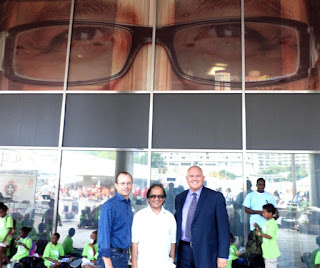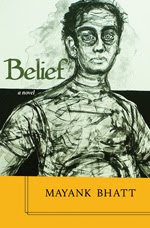 |
| Che - quietly confident |
 |
| Che & Mahrukh |
2012 brought major changes in our lives. In our fourth year in Canada, our need was to belong to a place that we so much wanted to call our home. Our quest for a home of our own was now the most important thing in our lives.
We moved into a larger apartment in the same building so that Che would have a room of his own.
 |
| Che looks cool & I'm trying to |
The apartment was bigger, but our need was not so much for space as it was for setting roots into this land, and for that, we needed a home of our own.
A greater part of 2012 was devoted to looking for a home, and we did that in our usual ham-handed manner.
Once again, Che rescued us. He’d seen a home that was on sale on Gibson Avenue just off Jane Street on Lawrence Avenue West; not too far from our rented apartment on Keele and Lawrence. We began the process in 2012 and moved into our new home the next year.
 |
With Mike Layton, Toronto Councillor
& Frank Scarpitti, Mayor of Markham at
the Arrivals launch |
I responded to a social media post seeking the participation of newcomers in a project called Arrivals. The purpose of the project was “focused on celebrating the stories of new citizens and asking how we can better welcome newcomers, and a better representation of the voices of newcomers in the Canadian narrative and the value they bring to Canada as a whole.”
A team led by Devon Ostrom, an art curator and public art advocate, conceived the project which comprised taking photographs of the eyes of newcomers and putting them up on Toronto’s City Hall. It was to depict how newcomers saw Toronto, reversing the notion of the newcomers being under scrutiny.
 |
| The eyes at City Hall |
I was selected based on my written submission – a short essay about my immigrant experience.
A volunteer from the organisation Helena Shimeles interviewed me. She was so involved in her questions and in understanding my experiences that I cried while answering some of the questions.
The second part of the project was an insertion of short announcements under a new section called Arrivals in the traditional births and deaths classified announcements of the Toronto Star. A friend saw the announcement ad and despaired that I’d died.
The project got enormous participation and I met Che Kothari, a young photographer, who clicked a totally clichéd photograph where I posed holding my chin. An enlarged version of that photograph was gifted to each participant.
I met the super talented Haniely Pableo, a young Filipino singer, who was also a part of the project. I also met the super talented Ravi Jain again.
 |
| With Haniely Pableo (right) and another participant |
2012 turned out to be a memorable year because Mahrukh joined Home Depot, initially as a garden supplies part-timer, and then gradually, over the next six years, through sheer dint of hard work, tenacity and determination, she finally became a permanent employee this year (2018).
I’ve probably said this earlier, but I’m happy reiterating it and reemphasizing it – that the biggest transformation in our family after we came to Canada has been in Mahrukh.
She was always an independent-minded woman, who has always known what she wanted, and has gone all out to get it; she’s also had the sagacity to accept things that she cannot change. Her presence in our lives has made our transition to Canada truly meaningful.
The year also began well for Che, and he was now at the York Memorial Collegiate for his high school. It was during this phase and especially when he was in Grade 10 that he suddenly developed anxiety issues that spiralled out of control until intervention by a psychologist helped him cope and then overcome these challenges.
As a family, we were ill prepared for this upheaval and suddenly our lives changed. We went through a harrowing time for more than two years; more so because we weren’t aware of the matter. I’ve always felt that the main cause of this was the burden of expectations that we had put on his delicate shoulders. He was unable to express his discomfort with his situation as a newcomer to the Canadian education system, and while he’d tried to adjust to everything that happened, without any complaints, he was unable to live up to the expectations that we had of him.
 |
| With Mike Layton |
Che was unable to complete his High School within the stipulated time; it was delayed by a year. But, he remained very much the responsible immigrant child who knew the struggle that the family had gone and was going through to survive in Canada; he was an integral part of that struggle.
He didn’t want to be perceived as a burden and started looking for a job even while he was going through the mental trauma. On his own found a job soon after completing his High School. His mental health treatment continued for a while, and he dropped out of the program in television broadcasting that he started after completing his High School.
One of the struggles that we face in our lives is the unnecessary stigma that we attach to mental health. I’ve never understood why this is the case. If it’s natural to go to a doctor when we have some physical ailment, why shouldn’t it be equally natural to go to a doctor when we have a mental ailment.
It is also during such times that we experience the pettiness of people we know, and who claim to be our friends. A memory that will never fade away is of a few such “friends” mocking our child’s inability to do well at school, without knowing the hard time he was going through.
In the Indian context, 2012 turned out to be a year when we lost one of the tallest cultural ambassadors of India – a man who perhaps single-handedly created more awareness about Indian classical music than anyone else did.
Ravi Shankar, the acclaimed sitar maestro, passed away on 12-12-12. In the universe of music, there is no musical instrument better than the sitar, and nobody could play it as Ravi Shankar did.
And Indian film industry lost its first superstar Rajesh Khanna on 18 July 2012. There are many ways to remember Rajesh Khanna. I remember him for putting the fear of Bhagwan Ram in Lal Krishna Advani’s heart in the 1991 election when Advani won by the thinnest of margins from the New Delhi constituency. (Read the blog on his death here: Rajesh Khanna).
During the year, we also lost IK Gujral, perhaps India’s most erudite Prime Minister; and the technocrat administrator responsible for the white revolution in India – VG Kurien.
 |
| Coverage in Globe & Mail |
Bal Thackeray also passed away in 2012. As a journalist, I had interviewed him on a couple of occasions and then during one interview when I was at the Sunday Observer, I’d asked him who’d succeed him (two decades before he’d pass into history). He was apparently so disturbed by the question that he refused to meet me ever thereafter.
Bal Thackeray, without any doubt, is one of the most divisive political leaders to emerge in post-Independent India. But, he was not alone. Divisive politics has been the bane of Indian parliamentary democracy, and these leaders and their parties have had no qualms in exploiting the innate divisions within the Indian society for petty electoral gains.
In the process, seven decades after Independence, when India should have become a beacon of hope to humanity with its message of love and acceptance, it's standing on the edge of the proverbial precipice, riven with hatred, intolerance and majoritarian violence.
In 2012, Ajmal Kasab, the sole surviving terrorist of the bunch that attacked Bombay in November 2008, was sentenced to death. I’m opposed to the death penalty, but on this occasion, I didn’t protest.
I also lost a friend and former colleague Eva Doctor, who suddenly passed away on 26 July 2012. We worked in different sections in the US Consulate while I was there, and I'd periodically take time out and sit with her to chat about nothing in particular and come away relaxed.
One needs at least one friend in a workplace with whom one can be oneself without pretence. Someone who can bring a semblance to sanity to an otherwise toxic and vicious place that most workplaces tend to be, and that the US Consulate in Bombay was definitely at that time.













No comments:
Post a Comment